2012 Peugeot 207 CC warning
[x] Cancel search: warningPage 99 of 224

6
!
SAFETY
97
The ESP/ASR systems offer ex-
ceptional safety in normal driving,
but this should not encourage the
driver to take extra risks or drive at
high speed.
The correct functioning of these
systems depends on observation
of the manufacturer's recommen-
dations regarding the wheels (tyres
and rims), the braking components,
the electronic components and the
PEUGEOT assembly and opera-
tion procedures.
After an impact, have these sys-
tems checked by a PEUGEOT
dealer.
Deactivation
In exceptional conditions (starting a ve-
hicle which is bogged down, stuck in
snow, on soft ground, ...), it may be ad-
visable to deactivate the ASR and ESP
systems, so that the wheels can move
freely and regain grip.
�)
Press the "ESP OFF"
button, located
in the centre of the dashboard.
If this warning lamp comes on on the in-
strument panel and the indicator lamp on
the button comes on, this indicates that the
ASR and ESP systems are deactivated.
Reactivation
These systems are reactivated automat-
ically each time the ignition is switched
back on or from 30 mph (50 km/h).
�)
Press the "ESP OFF"
button again
to reactivate them manually.
Operating fault
If this warning lamp comes on,
accompanied by an audible sig-
nal and a message on the multi-
function screen, this indicates a
malfunction of these systems.
Have them checked by a PEUGEOT dealer.
TRAJECTORY CONTROL
SYSTEMS
Activation
These systems are activated automati-
cally each time the vehicle is started.
Anti-slip regulation (ASR) and
electronic stability programme
(ESP)
They come into operation in
the event of a grip or trajectory
problem.
This is indicated by fl ashing of
this warning lamp in the instru-
ment panel.
The anti-slip regulation (also known as
Traction Control) optimises traction to
prevent skidding of the wheels, by act-
ing on the brakes of the driving wheels
and on the engine.
The electronic stability programme acts
on the brake of one or more wheels and
on the engine to keep the vehicle on the
trajectory required by the driver, within
the limits of the laws of physics.
Page 100 of 224
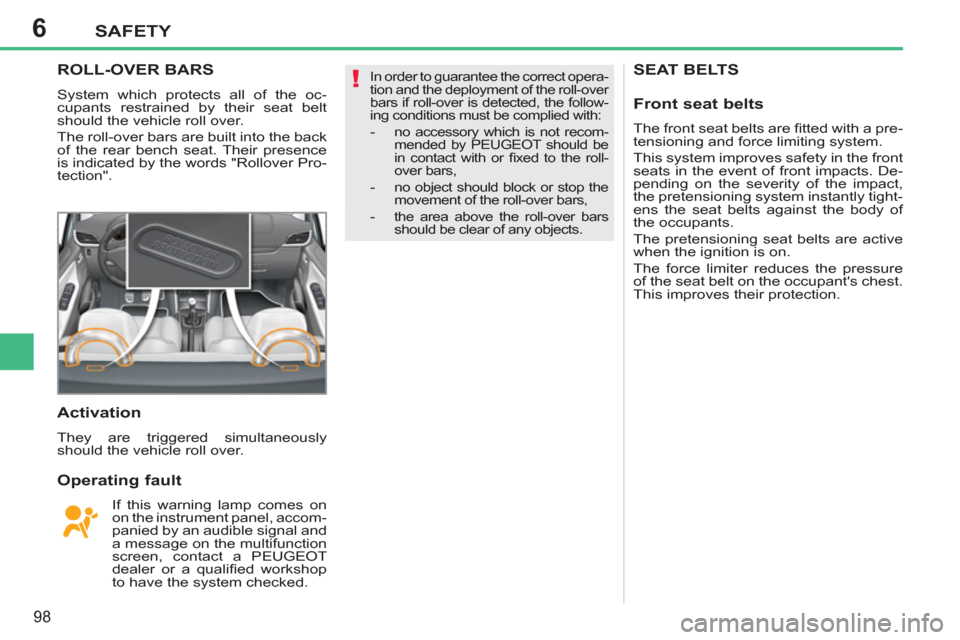
6
!
SAFETY
98
SEAT BELTSROLL-OVER BARS
System which protects all of the oc-
cupants restrained by their seat belt
should the vehicle roll over.
The roll-over bars are built into the back
of the rear bench seat. Their presence
is indicated by the words "Rollover Pro-
tection".
Activation
They are triggered simultaneously
should the vehicle roll over.
Operating fault
If this warning lamp comes on
on the instrument panel, accom-
panied by an audible signal and
a message on the multifunction
screen, contact a PEUGEOT
dealer or a qualifi ed workshop
to have the system checked.
In order to guarantee the correct opera-
tion and the deployment of the roll-over
bars if roll-over is detected, the follow-
ing conditions must be complied with:
- no accessory which is not recom-
mended by PEUGEOT should be
in contact with or fi xed to the roll-
over bars,
- no object should block or stop the
movement of the roll-over bars,
- the area above the roll-over bars
should be clear of any objects.
Front seat belts
The front seat belts are fi tted with a pre-
tensioning and force limiting system.
This system improves safety in the front
seats in the event of front impacts. De-
pending on the severity of the impact,
the pretensioning system instantly tight-
ens the seat belts against the body of
the occupants.
The pretensioning seat belts are active
when the ignition is on.
The force limiter reduces the pressure
of the seat belt on the occupant's chest.
This improves their protection.
Page 101 of 224
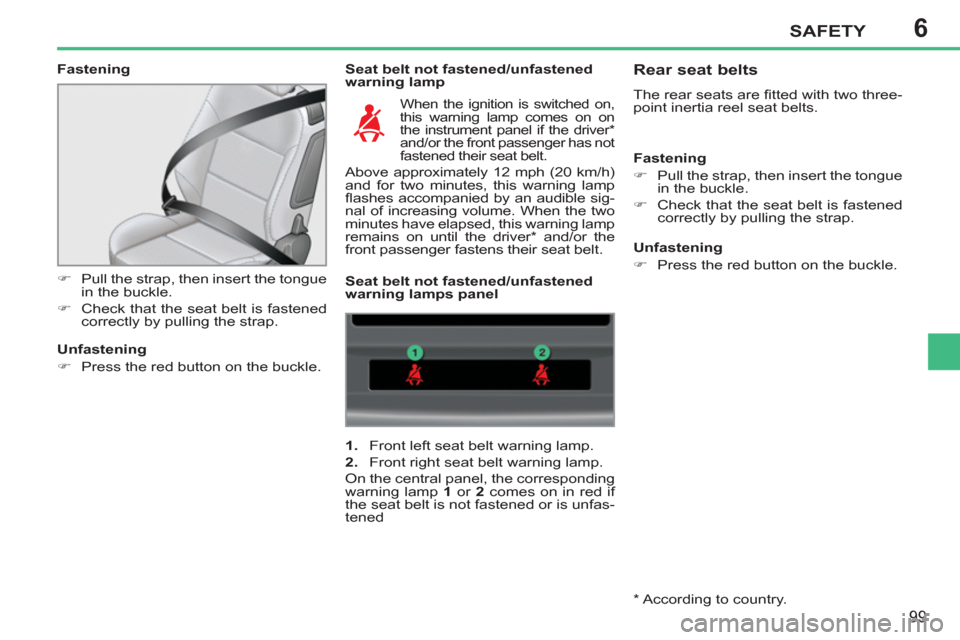
6SAFETY
99
Fastening
Seat belt not fastened/unfastened
warning lamp
�)
Pull the strap, then insert the tongue
in the buckle.
�)
Check that the seat belt is fastened
correctly by pulling the strap.
When the ignition is switched on,
this warning lamp comes on on
the instrument panel if the driver *
and/or the front passenger has not
fastened their seat belt.
Above approximately 12 mph (20 km/h)
and for two minutes, this warning lamp
fl ashes accompanied by an audible sig-
nal of increasing volume. When the two
minutes have elapsed, this warning lamp
remains on until the driver * and/or the
front passenger fastens their seat belt.
Unfastening
�)
Press the red button on the buckle.
1.
Front left seat belt warning lamp.
2.
Front right seat belt warning lamp.
On the central panel, the corresponding
warning lamp 1
or 2
comes on in red if
the seat belt is not fastened or is unfas-
tened
Seat belt not fastened/unfastened
warning lamps panel
Rear seat belts
The rear seats are fi tted with two three-
point inertia reel seat belts.
Fastening
�)
Pull the strap, then insert the tongue
in the buckle.
�)
Check that the seat belt is fastened
correctly by pulling the strap.
Unfastening
�)
Press the red button on the buckle.
*
According to country.
Page 102 of 224
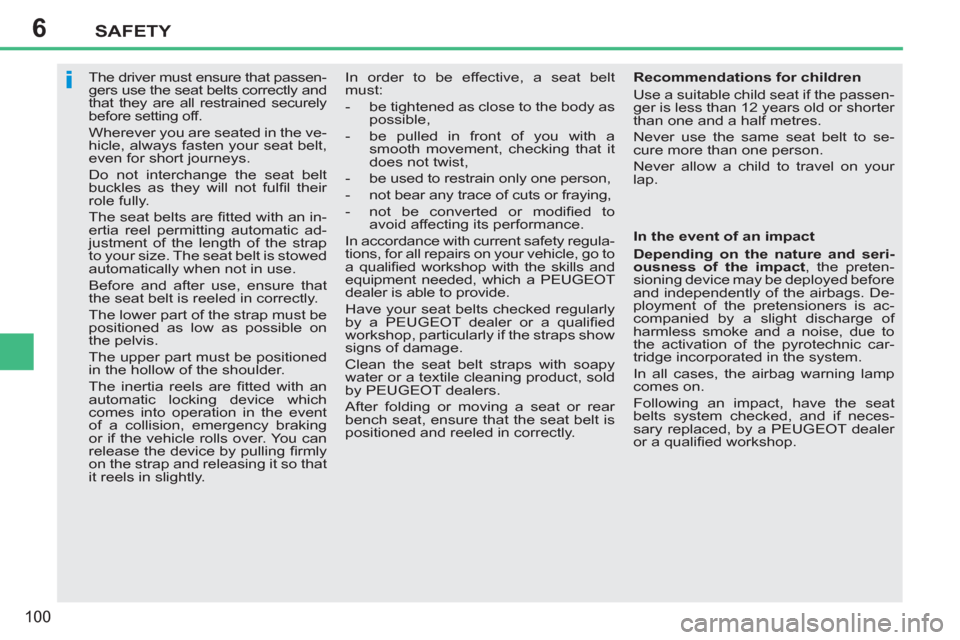
6
i
SAFETY
100
The driver must ensure that passen-
gers use the seat belts correctly and
that they are all restrained securely
before setting off.
Wherever you are seated in the ve-
hicle, always fasten your seat belt,
even for short journeys.
Do not interchange the seat belt
buckles as they will not fulfi l their
role fully.
The seat belts are fi tted with an in-
ertia reel permitting automatic ad-
justment of the length of the strap
to your size. The seat belt is stowed
automatically when not in use.
Before and after use, ensure that
the seat belt is reeled in correctly.
The lower part of the strap must be
positioned as low as possible on
the pelvis.
The upper part must be positioned
in the hollow of the shoulder.
The inertia reels are fi tted with an
automatic locking device which
comes into operation in the event
of a collision, emergency braking
or if the vehicle rolls over. You can
release the device by pulling fi rmly
on the strap and releasing it so that
it reels in slightly. In order to be effective, a seat belt
must:
- be tightened as close to the body as
possible,
- be pulled in front of you with a
smooth movement, checking that it
does not twist,
- be used to restrain only one person,
- not bear any trace of cuts or fraying,
- not be converted or modifi ed to
avoid affecting its performance.
In accordance with current safety regula-
tions, for all repairs on your vehicle, go to
a qualifi ed workshop with the skills and
equipment needed, which a PEUGEOT
dealer is able to provide.
Have your seat belts checked regularly
by a PEUGEOT dealer or a qualifi ed
workshop, particularly if the straps show
signs of damage.
Clean the seat belt straps with soapy
water or a textile cleaning product, sold
by PEUGEOT dealers.
After folding or moving a seat or rear
bench seat, ensure that the seat belt is
positioned and reeled in correctly.
Recommendations for children
Use a suitable child seat if the passen-
ger is less than 12 years old or shorter
than one and a half metres.
Never use the same seat belt to se-
cure more than one person.
Never allow a child to travel on your
lap.
In the event of an impact
Depending on the nature and seri-
ousness of the impact
, the preten-
sioning device may be deployed before
and independently of the airbags. De-
ployment of the pretensioners is ac-
companied by a slight discharge of
harmless smoke and a noise, due to
the activation of the pyrotechnic car-
tridge incorporated in the system.
In all cases, the airbag warning lamp
comes on.
Following an impact, have the seat
belts system checked, and if neces-
sary replaced, by a PEUGEOT dealer
or a qualifi ed workshop.
Page 104 of 224

6
!
!
SAFETY
102
To assure the safety of your child,
it is imperative that the passenger's
airbag is deactivated when you in-
stall a "rear facing" child seat on
the front passenger seat.
Otherwise, the child would risk be-
ing seriously injured or killed if the
airbag were deployed.
If both airbag warning lamps come
on continuously, do not install a
"rear facing" child seat on the front
passenger seat.
Have it checked by a PEUGEOT
dealer or a qualifi ed workshop.
Deactivation
Only the front passenger's airbag can
be deactivated:
�)
with the ignition off
, insert the key
in the passenger airbag deactivation
switch 1
,
�)
turn it to the "OFF"
position,
�)
then, remove the key keeping the
switch in the new position.
According to version, this warn-
ing lamp comes on either in the
instrument panel or in the cen-
tral panel when the ignition is
on and until the airbag is reac-
tivated.
Reactivation
When you remove the child seat, turn
switch 1
to the "ON"
position to reacti-
vate the airbag and so assure the safety
of your front passenger in the event of
an impact.
Operating fault
If this warning lamp comes on in
the instrument panel, accompa-
nied by an audible warning and
a message in the multifunction
screen, contact a PEUGEOT
dealer or a qualifi ed workshop to have
the system checked. The airbags may
no longer be deployed in the event of a
serious impact.
Page 105 of 224
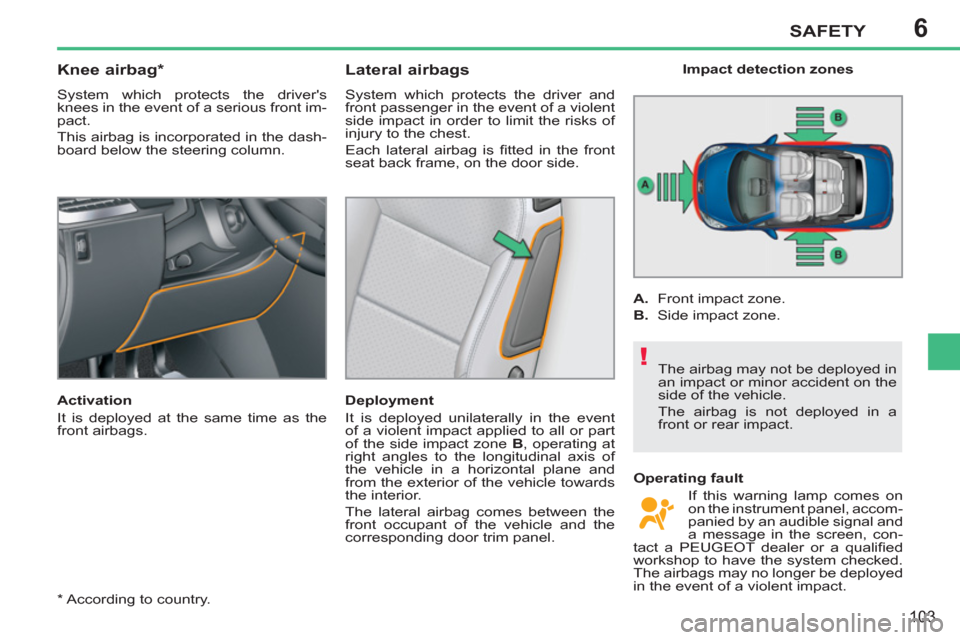
6
!
SAFETY
103
*
According to country.
Knee airbag *
System which protects the driver's
knees in the event of a serious front im-
pact.
This airbag is incorporated in the dash-
board below the steering column.
Activation
It is deployed at the same time as the
front airbags.
Lateral airbags
System which protects the driver and
front passenger in the event of a violent
side impact in order to limit the risks of
injury to the chest.
Each lateral airbag is fi tted in the front
seat back frame, on the door side.
Deployment
It is deployed unilaterally in the event
of a violent impact applied to all or part
of the side impact zone B
, operating at
right angles to the longitudinal axis of
the vehicle in a horizontal plane and
from the exterior of the vehicle towards
the interior.
The lateral airbag comes between the
front occupant of the vehicle and the
corresponding door trim panel.
Impact detection zones
A.
Front impact zone.
B.
Side impact zone.
The airbag may not be deployed in
an impact or minor accident on the
side of the vehicle.
The airbag is not deployed in a
front or rear impact.
Operating fault
If this warning lamp comes on
on the instrument panel, accom-
panied by an audible signal and
a message in the screen, con-
tact a PEUGEOT dealer or a qualifi ed
workshop to have the system checked.
The airbags may no longer be deployed
in the event of a violent impact.
Page 107 of 224

7
!
!
i
DRIVING
105
When parking on a slope, direct
your wheels against the pavement,
apply the parking brake and en-
gage a gear.
PARKING BRAKE
Applying
�)
Pull the parking brake lever fully up
to immobilise your vehicle.
When the vehicle is being driven, if this
warning lamp and the STOP
warning
lamp come on, accompanied by an
audible signal and a message on the
multifunction screen, this indicates that the parking
brake is still on or has not been properly released.
Releasing
�)
Pull the parking brake lever gently,
press the release button then lower
the lever fully.
Engaging 5th or 6th gear
�)
Move the lever fully to the right to
engage 5th or 6th gear.
Only engage reverse gear when
the vehicle is stationary with the
engine at idle.
As a safety precaution and to facili-
tate starting of the engine:
- always select neutral,
- press the clutch pedal.
Engaging reverse gear
�)
Raise the ring under the knob and
move the gear lever to the left then
forwards.
Page 111 of 224
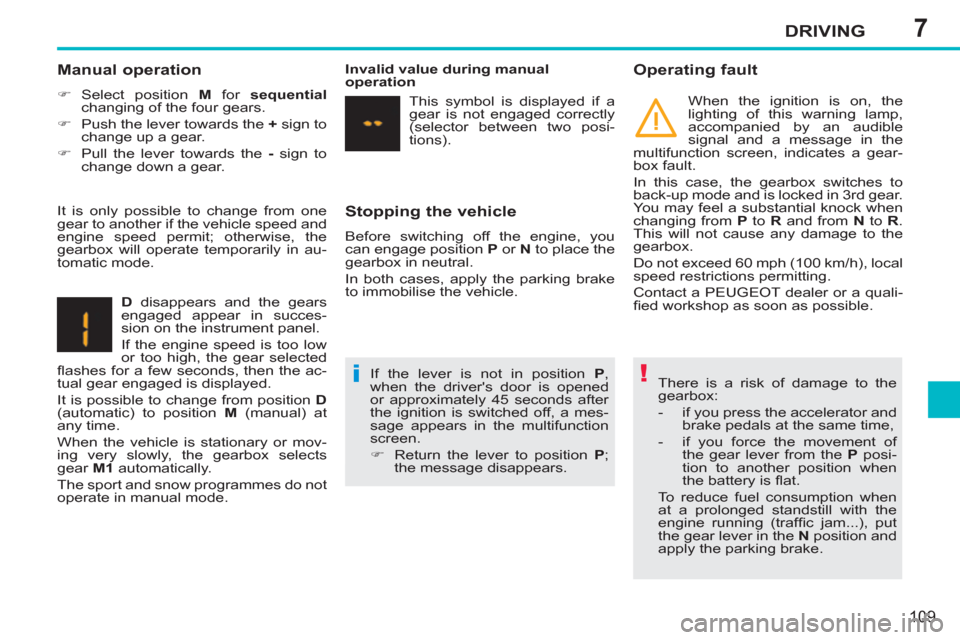
7
!i
DRIVING
109
Stopping the vehicle
Before switching off the engine, you
can engage position P
or N
to place the
gearbox in neutral.
In both cases, apply the parking brake
to immobilise the vehicle.
Operating fault
There is a risk of damage to the
gearbox:
- if you press the accelerator and
brake pedals at the same time,
- if you force the movement of
the gear lever from the P
posi-
tion to another position when
the battery is fl at.
To reduce fuel consumption when
at a prolonged standstill with the
engine running (traffi c jam...), put
the gear lever in the N
position and
apply the parking brake.
Manual operation
�)
Select position M
for sequential
changing of the four gears.
�)
Push the lever towards the +
sign to
change up a gear.
�)
Pull the lever towards the -
sign to
change down a gear.
D
disappears and the gears
engaged appear in succes-
sion on the instrument panel.
If the engine speed is too low
or too high, the gear selected
fl ashes for a few seconds, then the ac-
tual gear engaged is displayed.
It is possible to change from position D
(automatic) to position M
(manual) at
any time.
When the vehicle is stationary or mov-
ing very slowly, the gearbox selects
gear M1
automatically.
The sport and snow programmes do not
operate in manual mode. If the lever is not in position P
,
when the driver's door is opened
or approximately 45 seconds after
the ignition is switched off, a mes-
sage appears in the multifunction
screen.
�)
Return the lever to position P
;
the message disappears.
It is only possible to change from one
gear to another if the vehicle speed and
engine speed permit; otherwise, the
gearbox will operate temporarily in au-
tomatic mode.
Invalid value during manual
operation
This symbol is displayed if a
gear is not engaged correctly
(selector between two posi-
tions).
When the ignition is on, the
lighting of this warning lamp,
accompanied by an audible
signal and a message in the
multifunction screen, indicates a gear-
box fault.
In this case, the gearbox switches to
back-up mode and is locked in 3rd gear.
You may feel a substantial knock when
changing from P
to R
and from N
to R
.
This will not cause any damage to the
gearbox.
Do not exceed 60 mph (100 km/h), local
speed restrictions permitting.
Contact a PEUGEOT dealer or a quali-
fi ed workshop as soon as possible.